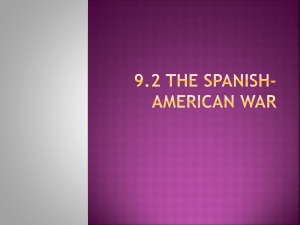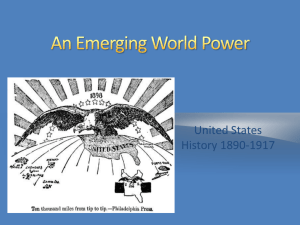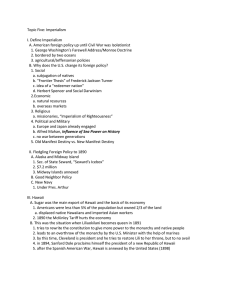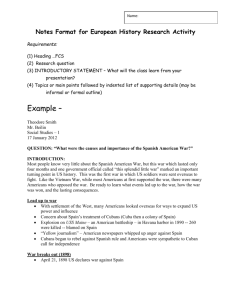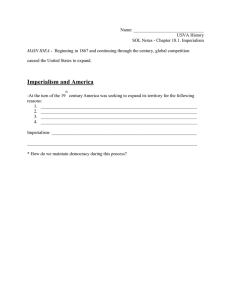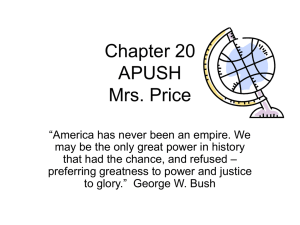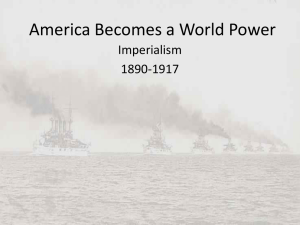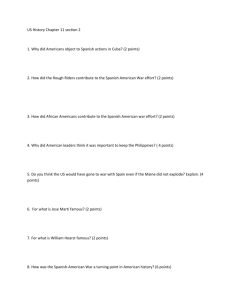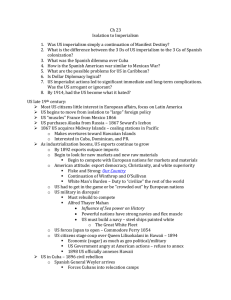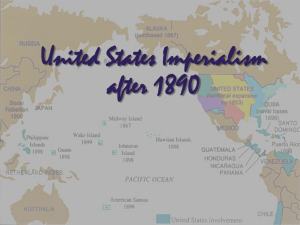EOC Review Day 4 - OCPS TeacherPress
advertisement
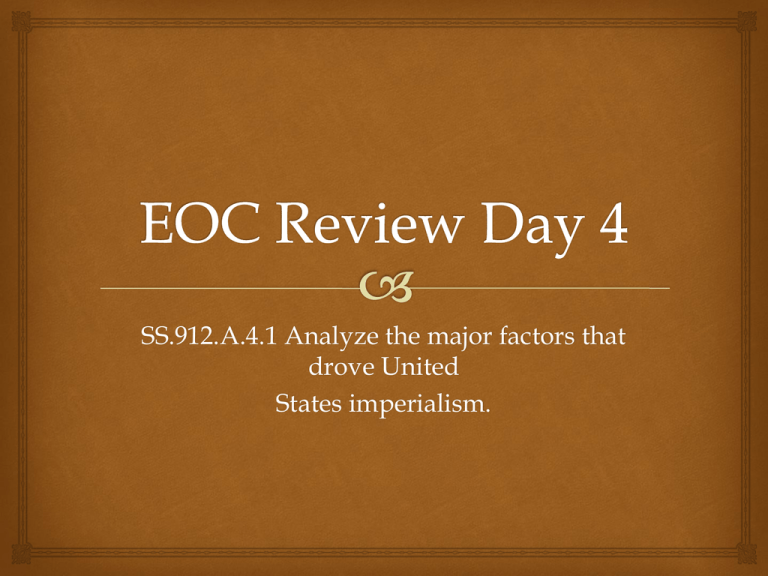
SS.912.A.4.1 Analyze the major factors that drove United States imperialism. SS.912.A.4.1 Analyze the major factors that drove United States imperialism. Captain Alfred Thayer Mahan: The Influence of Sea Power upon History, (1890) Thesis: Control of the sea was the key to world dominance and empire. U.S. should build large navy and build defensive bases and refueling stations strategically placed on world’s oceans. Take Hawaii and other Pacific islands. Josiah Strong: Our Country Advocated superiority of Anglo-Saxon civilization Urged Americans spread religion and democratic values to “backward” peoples. SS.912.A.4.3 Examine causes, course, and consequences of the Spanish-American War. Direct Cause of Spanish-American war USA sent a ship to support and protect Americans in danger in Cuba Explosion of the USS Maine-1898 266 soldiers dead Remember the Maine! To hell with Spain! Yellow Journalism Joseph Pulitzer and William Randolph Hurst Used their positions as journalists to support the concept of war Hearst sent artist Frederic Remington to Cuba to draw sketches. “Your furnish the pictures, I’ll furnish the war.” Course of Spanish American War USA much weaker than Spain militarily Theodore Roosevelt and the “Rough Riders” led the army on the Ground in Cuba US navy completely destroyed the Spanish fleet Teller Amendment-assured the world that Cuba would be returned to its people after the war Spanish American war in the Philippines When fighting began the US sent ships to attack Spain’s Philippine holdings US destroyed 10 Spanish ships and killed or wounded 400 Spainards in the Philippines SS.912.A.4.2 Explain the motives of the United States’ acquisition of the territories. The United States increased their policy of Imperialism after the Spanish American War. Annexation of Hawaii (July 1898) U.S. used the pretense of needing Hawaii as military naval base. Annexation of Hawaii was rushed through Congress and approved by President McKinley Hawaiians granted U.S. citizenship and received full territorial status in 1900. U.S. Army invaded Puerto Rico U.S. sought to take the island before the war with Spain ended. Most of population regarded U.S. soldiers as liberating heroes. Spain signed an Armistice on August 12, 1898. Treaty of Paris Treaty of Paris, 1898 Cuba freed from Spain U.S. received Pacific island of Guam which they had captured early in the war. U.S. gained Puerto Rico. Imperialism Debate Anti-Imperialist League Williams Jennings Bryan (Democrat) Feared lower wages for immigrants, factories relocating overseas Did not want to increase size of military because it would increase taxes Platt Amendment Changed the Teller Amendment to give the US the ability to reinvade Cuba if neccessary Insurrection in the Philippines Filipinos assumed they would be granted freedom after the war, like the Cubans. Open rebellion began Feb. 1899; Emilio Aguinaldo declared Philippines independent. More savage fighting and resulted in more casualties than Spanish American War. Filipino armies fled to the jungle where they waged vicious guerrilla warfare. Insurrection finally broken in 1901 when Aguinaldo was captured. China Open Door Policy-Agreement between the western countries granting equal rights to trading ports in China Written by the United States Increased the US presence in Asia Boxer Rebellion-Chinese uprising put down by Japan, Russia, Britain, France, Germany and US troops. SS.912.A.4.4 Analyze the economic, military, and security motivations of the United States to complete the Panama Canal as well as major obstacles involved in its construction. Theodore Roosevelt- “Big Stick Policy” Panama Canal- United States helped Panama fight off Columbian rulers Took Control of Panama and built the Canal to improve shipping and naval efficiency Disease and death plagued construction Dollar Diplomacy China -- Manchurian Railroad Scheme 1909, Taft proposed that a group of U.S. and foreign bankers buy the railroads and turn them over to China. Japan and Russia refused to give up important railroads. President Taft showered in ridicule. Caribbean Taft urged Wall Street bankers to loan money to Honduras and Haiti to keep out foreign funds. Ultimately, U.S. sent forces to Cuba, Honduras, the Dominican Republic, and Nicaragua to keep control and order. Missionary Diplomacy Latin America and the Caribbean Kept Marines in Nicaragua making that country, in effect, a U.S. protectorate. U.S. forces sent to Haiti in 1914-15 when Haitian president torn to pieces. 1916, U.S. Marines sent to Dominican Republic when riots and civil war broke out. 1917, U.S. purchased Virgin Islands from Denmark
